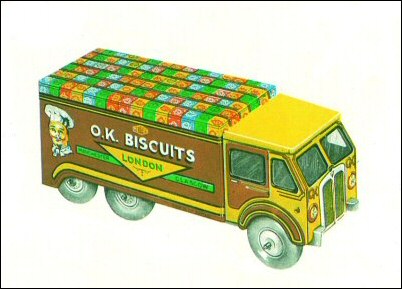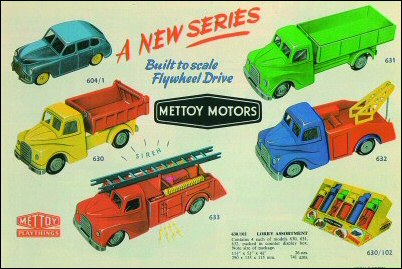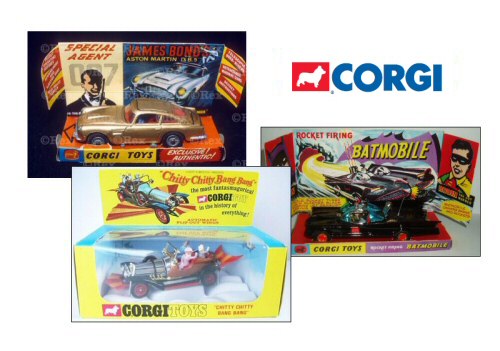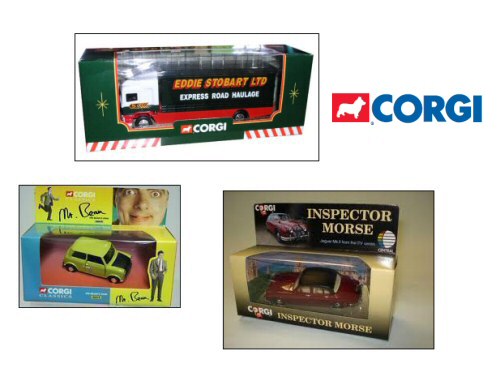Founded in 1956 Corgi has captured the hearts of
hundreds of thousands of boys with its 60+ years
history of manufacturing die cast toys. What were
toys to the children of the 50’s, 60’s and
70’s are now high priced collectable items, with
some toys fetching thousands of pounds at auctions
today. Corgi still today produce both toys and
collectables, with ranges of high quality limited
edition aircraft, trucks, cars, buses and TV and
Film memorabilia.

Corgi in the Making
Corgi Toys were originally manufactured by Mettoy
Limited, founded in Northampton in 1934 by Philip Ullman and Arthur
Katz. For the first four years, the company distributed stamped metal toys which
were designed and tooled
at the factory but manufactured elsewhere. In 1938,
Mettoy itself began to manufacture toys in Northampton. With the outbreak
of war, production was increasingly turned over to defence contracts and in
1941, toy manufacturing ceased completely.
By 1945, the Mettoy Swansea factory was up and
running again and 1946 saw the launch of the company’s first illustrated,
full colour catalogue. Three years later, thanks to Mettoy’s success in export
markets, a second factory at Swansea was leased. The company moved its
headquarters to Swansea in 1952, although design and development remained in
Northampton.
Welsh connections
In 1956, the manufacture of pressure die cast toys
began and the Corgi brand was born. The name was chosen because of its
association with royalty, and its Welsh connections – the Corgi dog
is a Welsh breed and the factory was based in Wales. The name also was short,
sharp, and easy to remember. Although die cast miniatures were no
longer a novelty, Corgi rapidly became a leader in toy vehicle
manufacturing, thanks to its ability to create models with an authentic appearance – cars
with windows, interior fittings and opening doors. Ten models went on sale
that year, four of which had flywheel motors.

Historic marques
As well as the Ford Consul, the Corgi range also
included the Austin Cambridge, Morris Cowley, Vauxhall
Velox, Hillman
Husky, Rover 90, Riley Pathfinder, Bedford 12cwt van, Austin Healey and
Triumph TR2. Towards the end of 1956, the Corgi Collector Club was launched
and the following year saw the first-ever Corgi catalogue and Corgi
advertising on TV.
1960’s
The ‘swinging sixties’ was a period of
innovation, with the development of intriguing features such as
opening
bonnets and boots, detailed engines, ‘Glidamatic’
suspension, jewelled headlights, figures and Corgi Kits.
Memorable models included the Chipperfield’s
Circus, Massey Ferguson tractor and Midland Red motorway express
coach. Most memorable of all, with over 10 million sales, was
the James Bond Aston Martin DB5, which marked the beginning of a
long relationship between Corgi and the Bond franchise.

On top of the world
The sixties were, in many ways, Corgi’s heyday. In
1961, Arthur Katz, Corgi’s managing director, received an OBE
for his services to the toy industry and over 7.5 million pieces were
sold. Corgi Toys reached its peak in 1967 and became a world
leader within the toy industry.
Up in flames
The end of the decade saw the introduction of
‘Golden Jacks’, a series of models with detachable
wheels and built-in
jacks, and the ‘fantasmagorical’ Corgi model of ‘Chitty
Chitty Bang Bang’, which cost 22 shillings. It wasn’t all good news -
in March 1969, a serious fire gutted the Swansea warehouse,
completely destroying a year’s worth of stock. The results
were devastating and customers turned to other brands for their
supplies.

1970’s
During the 70s, the company’s fortunes changed.
Mettoy had experienced a decline in sales in
previous years and by 1971 the Northampton factory
was dealing with redundancies. The situation
improved when the company reached an agreement with
Fisher Price to manufacture and distribute their
toys to the European market.
Film and TV specials
Mettoy’s new products included Corgi Juniors with
‘Whizzwheels’, designed to appeal to younger
children. Other key products of this period were
derived from film and TV series, such as ‘The
Magic Roundabout’, with its tremendous play value;
‘Batman’, ‘Kojak’, and ‘Tarzan’. In
1977, the James Bond ‘Underwater Lotus Esprit’
model was produced to coincide with the release of
the Bond film ‘The Spy Who Loved Me’.

Boom years
Peter Katz, son of Arthur Katz, became chairman in
1977. During the following year, the company enjoyed a rapid
recovery with peak profits. Aided by advantageous currency rates and a
boom in the popularity of toys associated with film and TV,
Mettoy recorded an increase in profits. Other manufacturers in the
industry were less fortunate – after financial struggles, well-known
brands such as Dinky and Lesney went into liquidation.
1980’s
At the start of the 80s, Mettoy adopted a strategy
of diversification and divestment to combat changes in
consumer trends.
Children were gradually rejecting traditional toys in favour
of computers and electronic toys, and the favourable export
conditions of the late 1970s were affected by the economic downturn.
Sales
were down by five million pieces, resulting in redundancies.
In 1982, Mettoy launched the Dragon computer, a highly acclaimed
family computer. Despite its initial success, the product
was never developed sufficiently and failed to keep up with
competing brands. A programme of divestment followed
but Mettoy could
not find a way to survive and save the business.
Management rescue
In 1983, an official receiver was called in;
however, by March 1984, a successful management buy-out
had taken
place, resulting in the formation of a new company,
‘Corgi Toys Ltd’. Under this new title, Corgi concentrated on its strengths
– the design and production of high quality die cast models. The
company worked hard to win back the confidence of the trade,
focusing on two distinct markets: the toy market and
the adult
collector.
1990’s
In spite of success and worldwide acclaim, a lack of
capital investment restricted Corgi’s range development.
In 1990, much of the production switched to the Far East. At the
same time, the company was taken over by the giant American toy
company, Mattel.
The age of nostalgia
In January 1991, the Swansea factory and offices
were closed and Corgi moved to Mattel’s UK headquarters in
Leicester. As well as producing models for the traditional toy market,
Mattel developed the ‘Classics’ range during the first half of
the 1990s, with the emphasis on commercial vehicles of the
50s and 60s -
‘the age of nostalgia’. The authenticity of the vehicle
designs and the exceptional attention to detail, combined with the
limited production, made these items extremely collectable, and they
were soon much in demand.
In the mid 90s, Corgi introduced the ‘Original
Omnibus’ range of 1:76 scale bus and coaches, a series of
collectable
items that are still produced today.
TV favourites
As well as these nostalgic pieces, Corgi continued
its interests in the world of TV, with the development
of models such as
‘Mr Bean’s’ Mini, ‘Inspector Morse’s’ Jaguar, and the
Morris Minor from ‘Some Mothers Do ‘Ave ‘Em’.
During this decade, Corgi experienced yet another
change of ownership. A consortium buyout, led by the managing
director of the time, resulted in the birth of ‘Corgi Classics
Ltd’.

2000 and onwards
The new millennium saw the launch of Corgi Classics
Inc, a sales and marketing operation based in Chicago, USA. The
UK company moved to a larger premises in Leicester; Corgi’s
new Gift Division was launched; and a number of new character
licensing deals were secured, including Enid Blyton’s ‘Noddy’,
for younger Corgi enthusiasts. Corgi also responded to collectors’
interests and reintroduced models associated with popular TV and film
characters, such as ‘Knight Rider’, ‘Charlie’s
Angels’, ‘Dr Who’, ‘Red Dwarf, and ‘Thunderbirds’.
Collectable wings and wheels
The early part of the decade also saw the
development and growth of the ‘Aviation Archive Collection’, a
series
of highly detailed collectable die cast aircraft, mainly from World War
Two. Corgi also introduced ‘Hauliers of Renown’, a range of 1:50
scale collectable trucks based on the vehicles then travelling the
roads of Britain, including those used by world famous transport and
logistics company, Eddie Stobart. Both of these collectable
series feature in today’s Corgi catalogues.
Memorable models
Within the collector and licensed model categories,
the most memorable models of the ‘noughties’ were
the
Scania R Series Truck, Bond Aston Martin Vanquish, ‘The New
Avengers’ Streakers, ‘Captain Scarlet’, ‘Little Red Tractor’,
Supermarine Spitfire (with working parts), Bristol Lodekka FS, and the
special
Corgi 50th anniversary edition Ford Consol. In May 2008, Hornby Hobbies Ltd purchased Corgi
for
£8.3 million: the company now sits comfortably under the Hornby
umbrella of hobby brands.